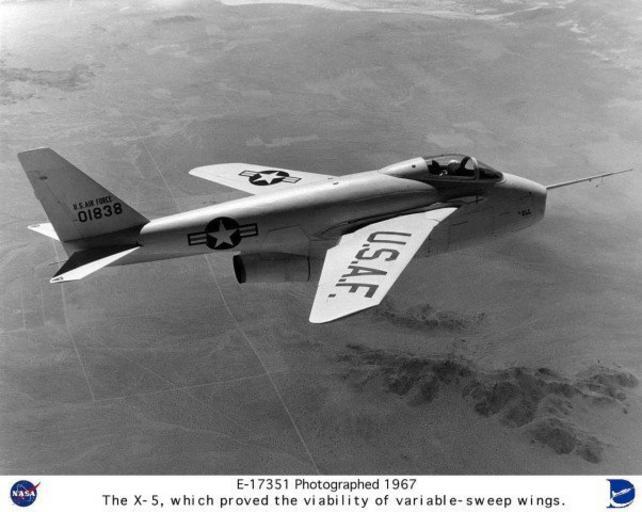MAKE A MEME
View Large Image

| View Original: | X-5_DVIDS717561.jpg (602x480) | |||
| Download: | Original | Medium | Small | Thumb |
| Courtesy of: | commons.wikimedia.org | More Like This | ||
| Keywords: X-5 DVIDS717561.jpg en This NACA High-Speed Flight Research Station photograph of the X-5 was taken at Edwards Air Force Base in the mid 1950s The photograph shows the aircraft in flight with the wings swept back The Bell X-5 was flight tested at the NACA High-Speed Flight Research Station now the NASA Dryden Flight Research Center Edwards California from 1952 to 1955 The X-5 was the first aircraft capable of sweeping its wings in flight It helped provide data about wing-sweep at angles of up to 60 degrees at subsonic and transonic speeds There were two X-5 vehicles Ship 1 was flown at the NACA High-Speed Flight Research Station High-Speed Flight Station as it was redesignated in 1954 from 1951 to 1955 Ship 2 was operated by Bell and the U S Air Force and was lost in a spin accident in 1953 Following the conclusion of the contractor's test program the X-5 was grounded for installation of a NACA instrument package The Air Force conducted a short six-flight evaluation program Since the Air Force evaluation program included data collection it was considered as part of the overall NACA effort and flights were logged as AF/NACA In the NACA test program the X-5 demonstrated severe stall-spin instability The X-5 was also used as a chase plane for other research aircraft because it could vary its flying characteristics to suit the airplane it was chasing Ship 1 flew a total of 133 flights during its three years of service In spite of the problems with the aircraft the X-5 provided a significant full-scale verification of NACA wind-tunnel predictions for reduced drag and improved performance that resulted from this configuration's increasing the wing sweep as the speed of the aircraft approached the speed of sound The X-5 flight tests provided some of the design data for the Air Force F-111 and Navy F-14 tactical aircraft Although the mechanism by which the X-5 changed its wing sweep made this particular design impractical development of a viable variable-sweep aircraft had to await Langley Aeronautical Laboratory's concept of an outboard wing pivot in the mid-1950s Langley was a NACA research laboratory in Hampton Virginia The X-5 was a single seat aircraft powered by an Allison J-35-A-17A jet engine It was 33 33 feet long with a wingspan of 20 9 feet with the wings swept back at an angle of 60 degrees to 33 5 feet with the wings unswept When fully fueled the X-5 weighed 9 875 pounds NASA Identifier NIX-EC-17351 2009-12-09 Glenn Research Center https //www dvidshub net/image/717561 717561 2012-10-10 18 21 WASHINGTON DC US PD-USGov Aircraft at Edwards Air Force Base Images from DoD uploaded by Fæ | ||||